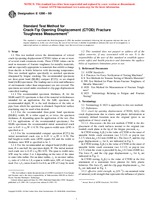Potřebujeme váš souhlas k využití jednotlivých dat, aby se vám mimo jiné mohly ukazovat informace týkající se vašich zájmů. Souhlas udělíte kliknutím na tlačítko „OK“.
ASTM E1290-99
Standard Test Method for Crack-Tip Opening Displacement (CTOD) Fracture Toughness Measurement
Automaticky přeložený název:
Standardní zkušební metoda pro Crack - Tip Otevření Zdvihový měření ( CTOD ) lomové houževnatosti
NORMA vydána dne 10.6.1999
Informace o normě:
Označení normy: ASTM E1290-99
Poznámka: NEPLATNÁ
Datum vydání normy: 10.6.1999
Kód zboží: NS-41152
Počet stran: 12
Přibližná hmotnost: 36 g (0.08 liber)
Země: Americká technická norma
Kategorie: Technické normy ASTM
Anotace textu normy ASTM E1290-99 :
Keywords:
Bend testing-metallic materials, Brittleness, Clip gage displacement, Cracking, Crack-tip opening displacement (CTOD), Crosshead displacement, CTOD values, C(T) specimen testing, Displacement, Ductility-metals/alloys, Ferritic steel, Fracture testing, Loading tests-metals/alloys, Metals and metallic materials, Pin loading, SE(B) specimen testing, Square section bend specimens, Steel, Structural applications-metals/alloys, Tension (tensile) properties/tests-metallic materials
Doplňující informace
| 1. Scope | ||||||||||||
|
1.1 This test method covers the determination of critical crack-tip opening displacement (CTOD) values at one or more of several crack extension events. These CTOD values can be used as measures of fracture toughness for metallic materials, and are especially appropriate to materials that exhibit a change from ductile to brittle behavior with decreasing temperature. This test method applies specifically to notched specimens sharpened by fatigue cracking. The recommended specimens are three-point bend [SE(B)] or compact [C(T)] specimens. The loading rate is slow and influences of environment (other than temperature) are not covered. The specimens are tested under crosshead or clip gage displacement controlled loading. 1.1.1 The recommended specimen thickness, , is that of the material in thicknesses intended for an application. Superficial surface machining may be used when desired. 1.1.2 For the recommended three-point bend specimens [SE(B)], width, , is either equal to, or twice, the specimen thickness, , depending upon the application of the test. (See 4.3 for applications of the recommended specimens.) For SE(B) specimens the recommended initial normalized crack size is 0.45 [<=] o/ [<=] 0.55. The span-to-width ratio ( / ) is specified as 4. 1.1.3 For the recommended compact specimen [C(T)] the initial normalized crack size is 0.45 [<=] o/ [<=] 0.55. The half-height-to-width ratio ( / ) equals 0.6 and the width to thickness ratio is within the range 2 [<=] / [<=] 4. 1.2 This standard does not purport to address all of the safety problems, if any, associated with its use. It is the responsibility of the user of this standard to establish appropriate safety and health practices and determine the applicability of regulatory limitations prior to use. |
||||||||||||
| 2. Referenced Documents | ||||||||||||
|
Doporučujeme:
Aktualizace technických norem
Chcete mít jistotu, že používáte pouze platné technické normy?
Nabízíme Vám řešení, které Vám zajistí měsíční přehled o aktuálnosti norem, které používáte.
Chcete vědět více informací? Podívejte se na tuto stránku.




 Cookies
Cookies
